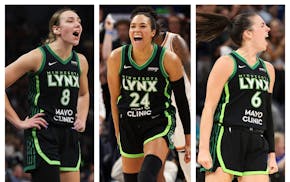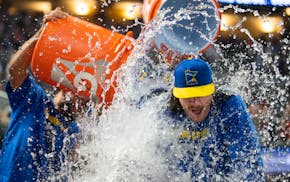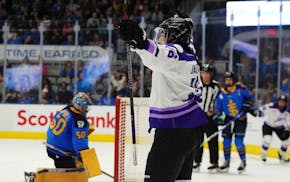Hamline junior Jason Picht is fortunate to be on a college baseball team that is able to be competitive against conference rival St. Thomas. He is aware not everyone at Hamline, or elsewhere in the Minnesota Intercollegiate Athletic Conference, is that lucky.
Take his friends on Hamline's football team, which last beat St. Thomas in 2007.
"We normally don't bring up St. Thomas to them," Picht said. "St. Thomas, to them, is kind of a touchy issue."
Consistent dominance on the playing field tends to have that effect, and Hamline's football team is by no means unique in the MIAC. When it comes to winning, no school in the conference wins as consistently in so many sports as St. Thomas.
The Tommies just completed their ninth consecutive season of winning the conference all-sports championship in both men's and women's sports. This winter, St. Thomas won or shared seven of eight conference regular-season titles, and was second in the other sport (men's hockey). The Tommies were 5-for-6 in spring sports titles. UST this season also won the NCAA Division III men's basketball championship and played in the football national title game.
By winning both the men's and women's conference track and field titles last weekend, the Tommies ended the academic year with 15 regular-season conference championships. That broke the previous record of 13, set by, of course, St. Thomas in 2011-12.
MIAC rivals had better get used to such results. The Tommies researched a potential move to NCAA Division I a decade ago, but instead decided that fielding winning D-III athletic programs better fit their philosophy. That mind-set remains solidly in place, St. Thomas athletic director Steve Fritz said.
Should St. Thomas move up from Division III? Vote here
And the athletic advantages enjoyed by St. Thomas nearly increased even more — and could at a future date. The conference this month considered new legislation on extending eligibility for those who have earned an undergraduate degree — the current conference rule is that eligibility expires after earning an undergraduate degree.
MIAC Commissioner Dan McKane worried that adopting the change could be "the breaking point" for some schools who wonder if the MIAC still is the right athletic fit. Schools with graduate programs likely would have benefited the most from a rule change, and St. Thomas has the most grad programs in the conference.
The proposed legislation passed conference athletic directors in April, but failed to gain approval of faculty/athletic representatives at a May 17 meeting. Although conference presidents have the right to rekindle the discussion at their Wednesday meeting, McKane said he believes that's unlikely.
With or without the change, MIAC rivals have their work cut out for them. MIAC administrators mostly praise St. Thomas for its athletic consistency, saying the Tommies' success offers other schools a model to follow.
"You've got to tip your hat to them, to be able to sustain the success they've had over a long period of time," St. Mary's AD Nikki Fennern said. "It's our job to figure out what we need to do to compete."
Easier said than done, because the playing field in the MIAC is by no means level. McKane presides over a 13-school conference whose members are diverse in athletic and academic philosophies, as well as admission standards and athletic budgets.
St. Thomas already has more advantages than most rivals in such areas as school size — it has the largest enrollment in the conference — athletic facilities and its location in the heart of the Twin Cities.
One conference athletic director said St. Thomas is likely to win the next 10 all-sports titles on top of its current nine-year run.
St. Thomas has made a conscious effort to excel at athletics, Fritz said, believing winning teams help afford the school a positive image that helps in marketing and attracting students.
But the model isn't for everyone.
Macalester AD Kim Chandler said that her school has "different drivers here, different value sets to be true to ourself. The academic component here plays a significant role for us."
Possible rule change
McKane said he believes his conference is the only D-III conference in America that does not allow graduates to earn a second degree or attend graduate school while retaining their four years of athletic eligibility. Supporters of the rule change, like most conference ADs, believe it makes sense because an increasing number of students now arrive on campus as freshmen having already earned significant college credits. Graduating in three years or even less has become a trend.
McKane said he thinks it likely that "this specific issue will be continued to be discussed in future meetings."
It's a touchy issue in the MIAC because Carleton, Concordia (Moorhead), Gustavus Adolphus, Macalester, St. Benedict and St. Olaf do not offer graduate classes, and St. John's has only a graduate seminary.
"That's a concerning piece of legislation," Carleton AD Gerald Young said. "For people who don't have grad schools, it's a concern." St. Olaf AD Ryan Bowles agreed, saying "not having a grad school is going to pose a little bit of an issue for us."
Macalester's Chandler said her concern with the rule would have been the ability of schools with grad programs to "grayshirt," which basically affords students five years to get in their four years of eligibility. If those students arrive on campus as freshmen with college credits, they could earn an undergrad degree in three years, and spend their final two years in grad school.
"We know there are Division III schools in the country that are grayshirting, that's my concern, if [a rule change] is used inappropriately," she said.
McKane said the faculty/athletic reps debated academic philosophy, not athletics. And their feeling, he said, is that "the MIAC should remain committed to its philosophy of an undergraduate conference."
Are changes coming?
The MIAC has had no change in membership since St. Benedict joined the conference in 1985, making it one of the most stable conferences in America. No one is planning to leave. But some administrators say they have to do their homework, keeping all options open.
Hamline AD Jason Verdugo said Wisconsin-Superior's recent move from the Wisconsin Intercollegiate Athletic Conference to the Upper Midwest Athletic Conference prompted him to do an analysis of the benefits of the switch, which he estimates will mean 55 more victories a year across all sports. Verdugo said he was only being "inquisitive," but added that winning helps in attracting prospective students and "keeping kids once they get on campus. Certainly, you want to have an environment that's very positive and very good and makes their experience worthwhile."
St. Catherine's AD Eric Stacey said his school has a standing committee that periodically examines athletic affiliation, and did so this year. At this point, Stacey said, the committee believes the MIAC remains the right fit.
"I do think that we will see some shifting in NCAA Division III conference membership throughout the Midwest over the next couple years," he said. "I am not sure what shifts will occur, or which conferences might be affected, but I do believe these are important conversations to have."
Macalester's football program left the MIAC in 2001, which prompted a rule change prohibiting conference members from leaving in a sport the conference offers. Many wonder if the three conference schools who are members of the Associated Colleges of the Midwest for elite academic schools — Macalester, Carleton and St. Olaf — someday could join other ACM schools athletically.
McKane and Fritz both say the Tommies don't dominate athletically as much as the all-sports standings might indicate. One example: The Tommies won the national men's basketball title, but lost to St. Olaf in the conference tournament final.
"I truly believe that we're strong nationally because of the people in our league," Fritz said. "You can't go into a national basketball tournament and do well unless you've seen a lot of things during the year. It's the same in every sport. We're facing competitive teams every week."
But athletes at other schools fully understand the challenge they face. Jamie Rubbelke, a senior star on the Hamline softball team, noted that the Pipers had a total of 13 women try out for the softball team, while UST had around 40.
"It's like crazy different," said Rubbelke, whose team finished tied for third in the MIAC. "They get to pick and choose, and we have 13 total."
Rubbelke said it's apparent to all the advantages St. Thomas has in "facilities, roster size, money. … It's admirable they want to be good at every sport, but at the same time, how many times do they get to be the all-sports champion? When does that become a question of how much better they are than everyone else?"

As Lynx 'run it back' this season, their bedrock is trio from the Class of '19

Paddack clings to perfection into the sixth inning, pitching the Twins past the Giants
Reusse: Twins play Giants, triggering Mays memories and a question: Can we get the Black players back?

Frost turn away Toronto, even PWHL playoff series at a win apiece
